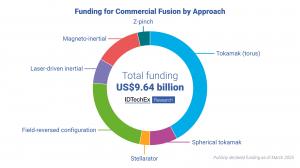IDTechEx Investigates if Fusion Energy is the 'Space Race' of the 21st Century
Catalyzed by the successes of experimental fusion reactors, around 50 startups have now emerged with the aim of commercializing nuclear fusion. IDTechEx’s market report “Fusion Energy Market 2025-2045: Technologies, Players, Timelines” takes a deep dive into the market leaders with industry timelines, materials and components, and a quantitative benchmarking scheme that assesses the seven most promising fusion approaches.
However, a burgeoning deep-tech industry like fusion will ultimately have to be supported by government strategy to stand a chance at long-term success. Over the last few years, national interest has grown as more nations and blocs see fusion as a 21st century “space race”. But who is leading the race, and is it just about money?
Cumulative publicly declared funding for commercial fusion companies, categorized by the different confinement approaches. Data gathered as of March 2025 and presented by IDTechEx.[NE1]
Fusion, fission – what’s the difference?
Nuclear fusion is a reaction in which two atomic nuclei are fused to form larger nuclei and neutrons. It is the process that powers main sequence stars such as the sun, and in terms of mass conversion is the most efficient way of generating energy. If achieved on a commercial scale, nuclear fusion would be a continuous source of green energy, with no risk of meltdown, and (in most cases) abundant supplies of fuel.
Unlike nuclear fission, fusion is powered by the lightest elements like hydrogen isotopes instead of heavy elements like uranium or thorium, and as a result does not produce any long-lived radioactive material. For this reason, fusion generally poses less of a safety risk than its nuclear cousin and is also less of a concern for proliferation.
Nevertheless, fusion still needs suitable regulation that fairly assesses the safety risks that do exist without stifling this emerging industry. Fortunately, governments and regulators seem to be keen to separate fusion and fission regulation, and open to input from scientists and industry to guide the regulatory process.
Growing demands for global energy
Irrespective of fusion’s success, the global demand for electricity will keep growing. With short-term drivers such as the rapid adoption of data centers for AI, and long-term drivers like global development and electrification, global electricity demand is expected to grow through to the end of the century.
Conventional green energy sources like wind or solar face an intermittency problem, where, without energy storage, they cannot provide a reliable base load energy or react to fluctuations in demand. This issue is becoming increasingly prevalent with the growing energy demand of data centers around the world, which is why tech giants like Google, Microsoft, and OpenAI’s CEO Sam Altman are all major investors in private fusion companies.
Which countries are leading the race for fusion?
While promising startups and research is being performed around the world, there are generally three blocs considered to be leading in the commercialization of fusion energy: the USA, China, and the European fusion effort.
The USA has the highest number of fusion startups and large private investments from industry giants and VC firms. Their national strategy includes the Department of Energy’s Milestone-Based Fusion Development Program, which has been praised by the fusion industry as a great framework for rewarding technical progress with additional funding. However, that same industry has also commented that the fusion program is critically underfunded, and that the state must do more to drive the industry forwards.
China, meanwhile, leads in public funding for fusion, far outspending any other nation. Despite having less of a history in fusion research, recent results from experiments like the EAST tokamak are promising, and Chinese startups like Energy Singularity have shown that fusion reactors can be built quickly and using largely sovereign materials.
However, there is less variety in the approaches taken by their fusion efforts, with most projects focusing on the popular tokamak approach and neglecting the promising alternatives that are being explored overseas.
Europe is home to the largest academic presence in fusion, with dozens of relevant research reactors and the largest talent pool for fusion researchers. France, a long-term supporter of nuclear energy, hosts the ITER tokamak, the largest international fusion project in history. Meanwhile, the UK hosted the Joint European Torus (JET) and in early June 2025 announced a record investment in fusion of £2.5 billion over the next 5 years.
However, Europe has repeatedly fallen flat in commercializing emerging technologies from research due to inefficient regulatory processes and smaller magnitudes of funding than the USA or China.
Market outlook
Chinese manufacturing is already a global powerhouse in many other new energy technologies like photovoltaics, batteries, and modern fission reactors. The point of anxiety for fusion startups in the west is therefore that fusion could become another technology that China commercializes and commodifies at a rapid pace, enabled by consistent government support.
From IDTechEx’s point of view, the race for fusion is far from over, with multiple different reactor designs, fusion fuels, and dozens of startups in the running. The market research report “Fusion Energy Market 2025-2045: Technologies, Players, Timelines” explores the most promising fusion approaches and key players, evaluating them with industry timelines and a quantitative benchmarking scheme based on data analysis and primary information from market leaders.
For more information on this report, including downloadable sample pages, please visit www.IDTechEx.com/Fusion, or for the full portfolio of energy research available from IDTechEx, see www.IDTechEx.com/Research/Energy.
About IDTechEx
IDTechEx provides trusted independent research on emerging technologies and their markets. Since 1999, we have been helping our clients to understand new technologies, their supply chains, market requirements, opportunities and forecasts. For more information, contact research@IDTechEx.com or visit www.IDTechEx.com.
Charlotte Martin
IDTechEx
+44 1223 812300
press|IDTechEx.com| |press|IDTechEx.com
Legal Disclaimer:
EIN Presswire provides this news content "as is" without warranty of any kind. We do not accept any responsibility or liability for the accuracy, content, images, videos, licenses, completeness, legality, or reliability of the information contained in this article. If you have any complaints or copyright issues related to this article, kindly contact the author above.
Former Google Exec Outlines the High-Stakes Battle Behind Google Reviews on Maury Blackman's Great Minds Think Data
Building Automation & Control Systems Market to Grow Strongly Driven by Energy Efficiency and Smart City Initiatives
Global Roof Truss Market Set for Strong Growth Driven by Urbanization and Sustainable Construction
Więcej ważnych informacji
 Jedynka Newserii
Jedynka Newserii

 Jedynka Newserii
Jedynka Newserii

Konsument

Wzrost sprzedaży piw bezalkoholowych idzie w parze z inwestycjami w zieloną energię. Kompania Piwowarska ogranicza ślad węglowy i wspiera lokalne inicjatywy
Kompania Piwowarska kontynuuję realizację strategii „Lepsza Przyszłość 2030”, w której łączy ambitne cele środowiskowe, edukacja konsumentów oraz rozwój segmentu piw bezalkoholowych z realnym wsparciem dla lokalnych społeczności. Firma, będąca liderem polskiego rynku piwa, ogranicza emisję CO₂, zwiększa udział opakowań zwrotnych i angażuje pracowników w wolontariat, w tym m.in. w pomoc dla ofiar powodzi na Dolnym Śląsku.
Handel
D. Joński: Europa musi chronić swój rynek poprzez cła i wysokie standardy bezpieczeństwa dla importowanych towarów. Powinniśmy budować własny przemysł oparty na tańszej energii

Tańsza energia, a przez to niższe koszty produkcji w Europie to jeden z kierunków, który wskazuje Unia Europejska w rywalizacji z tanimi towarami z Azji, głównie z Chin. Jednocześnie rynek Starego Kontynentu powinien być chroniony poprzez zbalansowane cła oraz wysokie standardy bezpieczeństwa stawiane importowanym produktom. Zdaniem europosła Dariusza Jońskiego ważne jest rozwijanie przemysłu w Europie bez względu na narodowość właścicieli. Relacje z Chinami muszą zostać na nowo zdefiniowane i przebiegać na równych zasadach.
Handel
Poprawia się jakość raportów dużych spółek giełdowych dotyczących zrównoważonego rozwoju. Pozostają też obszary do dopracowania

Ekspertki i eksperci z Deloitte’a przeprowadzili analizę ujawnień taksonomicznych spółek notowanych na Giełdzie Papierów Wartościowych, która objęła sprawozdania z działalności za rok 2024 w części dotyczącej zrównoważonego rozwoju. To trzeci rok ujawniania stopnia zgodności przedsiębiorstw z Taksonomią Unii Europejskiej, co przekłada się na zwiększoną jakość i porównywalność prezentowanych danych. Jednocześnie można oczekiwać, że inwestycje zgodne z Taksonomią będą coraz istotniejszym elementem strategii rozwoju przedsiębiorstw w kolejnych latach.
Partner serwisu
Szkolenia

Akademia Newserii
Akademia Newserii to projekt, w ramach którego najlepsi polscy dziennikarze biznesowi, giełdowi oraz lifestylowi, a także szkoleniowcy z wieloletnim doświadczeniem dzielą się swoją wiedzą nt. pracy z mediami.









.gif)

 |
| |
| |
|